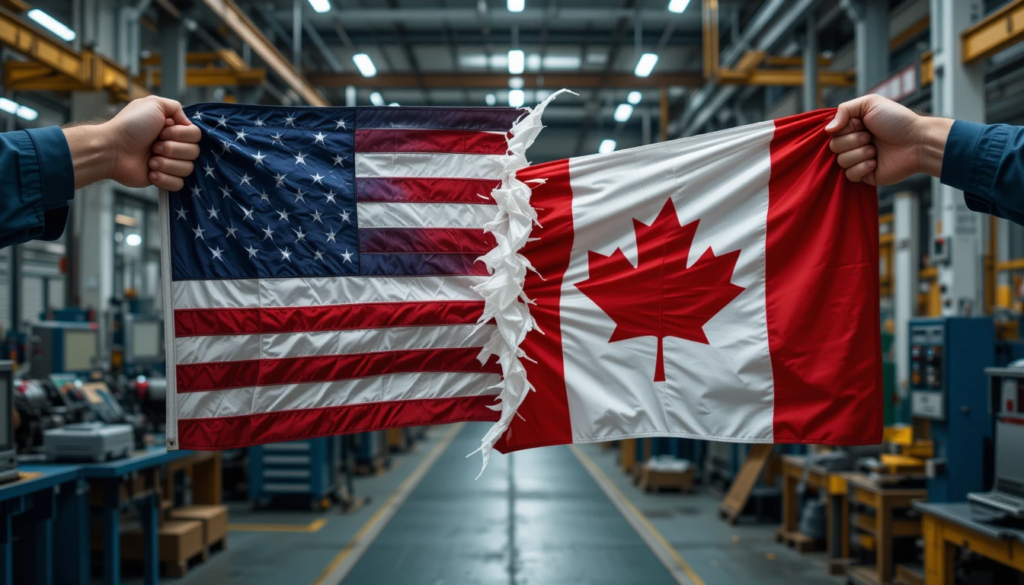
tariffs, Canada US trade war, US Canada relations, Mark Carney, Trump tariffs, USMCA, aluminum tariffs, steel tariffs, trade war 2025, Canada retaliation, US economy, Canadian economy, NAFTA breakdown, North American trade, supply chain disruption, car prices 2025, home prices increase, tariff impact, economic policy, protectionism, global trade, manufacturing crisis, American consumers, Canada exports, trade politics
What if buying a new car suddenly cost you $6,000 more—or your dream home went up by $22,000—overnight? That’s not inflation. That’s tariffs. And this time, Canada, America’s closest ally, is caught in the crossfire.
That’s not just about taxes or trade—but about trust, shifting alliances, and a new economic reality in North America. Today, we unpack why a 25% tariff on aluminum, steel, and copper imports from Canada—imposed by the U.S. under the banner of national security—is shaking up an entire continent.
Since the days of NAFTA and now the USMCA, the U.S. and Canada have built one of the world’s most integrated trade relationships. From intelligence to industry, the two countries have been partners in every sense. So why is Canada now being treated like a threat?
The U.S. used Section 232 of its Trade Expansion Act to justify these tariffs. But does Canadian copper or steel really pose a risk to U.S. security? Or is this part of a broader U.S. strategy to pressure China—one that’s roping in allies like Canada as collateral?
Rather than directly targeting China, the U.S. is using a sweeping strategy: impose tariffs broadly, then force countries into bilateral negotiations on America’s terms. Over 20 nations—including allies like Japan and South Korea—have been warned: negotiate, or face tariffs.
In this new game, multilateral deals like USMCA or WTO commitments are sidelined. Washington wants one-on-one deals where it holds the cards. And Canada? It’s stuck in the middle.
The fallout is real. Aluminum and steel exports from Canada to the U.S. are worth over CAD 15 billion annually. With tariffs, American buyers are paying up to CAD 3.75 billion more—a cost passed directly to consumers.
That means more expensive cars—up $6,000 per vehicle on average—and homes that now cost $22,000 more. Ford, Stellantis, and GM are already pausing production. And small businesses? Many can’t absorb these costs. Instead, they’re cutting jobs or moving operations to Mexico or India.
Canada isn’t shouting. But it’s not sitting still. Behind the scenes, the government is coordinating with industry leaders, drafting its own list of retaliatory tariffs, and considering a 25% tax on electricity exports to the U.S.—a move that would instantly raise production costs in American factories.
Meanwhile, Canada is diversifying. Exports to Europe and India are rising. Companies like Schneider Electric are expanding at home, investing in domestic manufacturing. “Build in Canada” is no longer a slogan—it’s becoming reality.
On the American side, citizens are feeling the pinch—higher car prices, costlier materials, and rising uncertainty in key sectors like manufacturing and construction. Many are asking: Are these tariffs really protecting American jobs—or making life harder for everyone?
Even in strongholds like Michigan and Ohio, there’s growing doubt. Instead of revitalizing American industry, these policies are pushing business elsewhere and leaving small companies to bear the brunt.
For decades, North America operated on the assumption of unity—a shared vision of prosperity. But with these tariffs, that unity is cracking. Canadians now understand that even the closest partnerships can shift. And Americans are realizing that protectionist policies may come with unintended costs.
So what now? Are we watching the end of a decades-long era of cooperation—or the start of a tougher, more independent trade reality?
One thing is clear: Both Canada and the U.S. are rethinking their place in the global economy. And while the tariffs may have started as leverage, they’re rapidly becoming a test of trust—and resilience.
Let us know your thoughts. Because this isn’t just a policy debate. It’s about jobs, families, and futures—on both sides of the border.





